
El Cuauhtémoc es un barco de la Armada de México con una historia fascinante que ha navegado por todo el mundo, hoy te cuento 5 curiosidades sobre este fascinante barco.
The Cuauhtémoc is a vessel of the Mexican Navy that boasts a fascinating history of global navigation. This article stands as an invitation to uncover the story and legacy of the Cuauhtémoc, and to appreciate the bravery and dedication of the men and women who have sailed aboard this vessel. (ENGLISH VERSION IS DOWN)
El dia 19 de abril, sobre las 10 de la mañana, cuando el sol empieza a calentar, los negocios abren y los tardíos para el trabajo corren y hacen lo imposible para coger un transporte, la ajetreada vida en la capital cubana se vió interrumpida por varios estruendos.
Muchos, incluyéndome, nos preguntamos: ¿Qué podía estar sucediendo? No era un día festivo, ni una fecha importante. Una ráfaga venía sucedida por una segunda, ya no quedaba duda era el recibimiento a un barco. En esta ocasión uno muy especial, pero no te apures de eso hablaremos pronto.
Si vienes de Twitter, sabrás el significado de la tradición que te hablo(si no lo sabes , cuando termines el artículo, llégate a Twitter 😉)
En mi presentación (mira al final) decía que iba a escribir sobre motores y aviación, nunca pensé que mi primer artículo fuera sobre velas y navegación… Sin más... vamos a conocer un poco de este trotamundos mexicano ...

Esta historia comienza conmigo tirando la mayor cantidad de fotos posible , desde el ángulo que se me ocurriese (Te confieso, que se poco de fotografía) Bueno, luego de una extensa cola , se entraba al recinto de la Aduana del Puerto desde donde se accede al embarcadero, donde se encontraba el Buque Escuela Cuauhtémoc , el protagonista de este artículo👇🏻
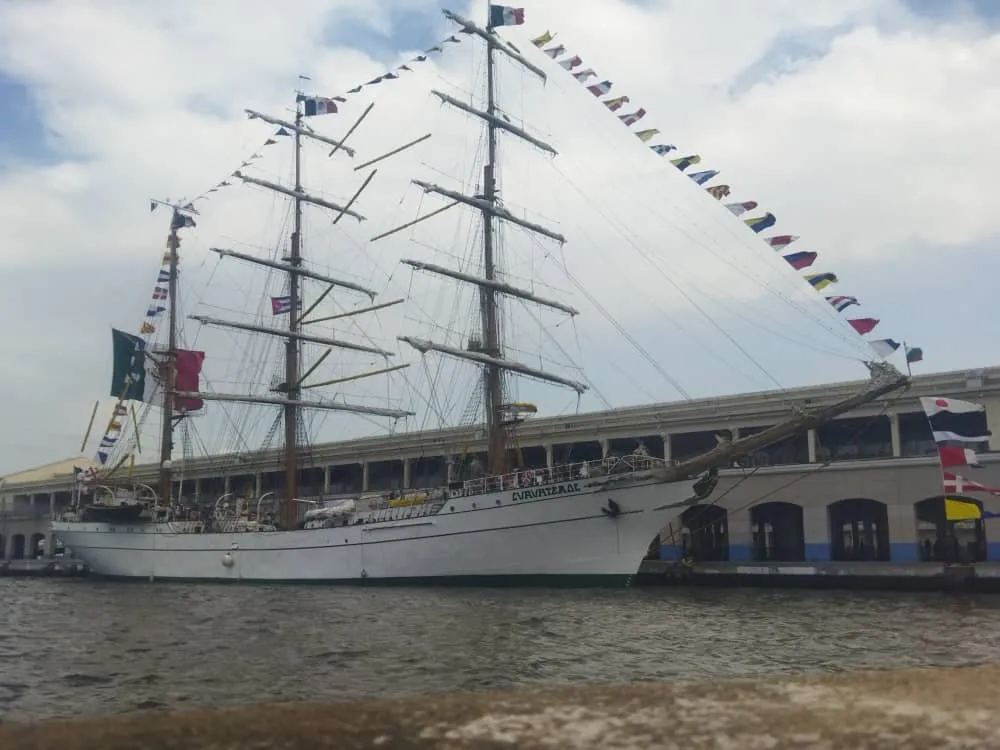

Para 1981, el presidente mexicano, ordenaba la construcción de un nuevo Buque Escuela, con el objetivo de reemplazar al anterior Cuauthémoc, que había servido a la Marina por 45 años y había sido licenciado en 1979.
El antiguo Cuauthémoc, era un velero de tres mástiles de tipo barquentina y el nuevo que se construiría no podía ser una réplica, debía ser totalmente distinto.
La construcción de la nueva insignia de la Marina Mexicana, le fue encargada a los reconocidos Astilleros y Talleres de Celaya, Bilbao, España (así quedó reflejado en la cubierta del barco). Luego de varias propuestas, se decidió construir una réplica moderna de los bergantines españoles del siglo 18. Para lo que se basaron, en su homólogo español, el Buque Escuela Juan Sebastián de Elcano (que también estuvo por Cuba en años anteriores)
En 1982, hace su primer viaje de entrenamiento y desde entonces ha estado sirviendo en la Marina Mexicana. Su principal función es la formación y entrenamiento de los cadetes de la Escuela Naval Militar. Pero es más que un escuela ... Sigue leyendo para que nadie te lo cuente.

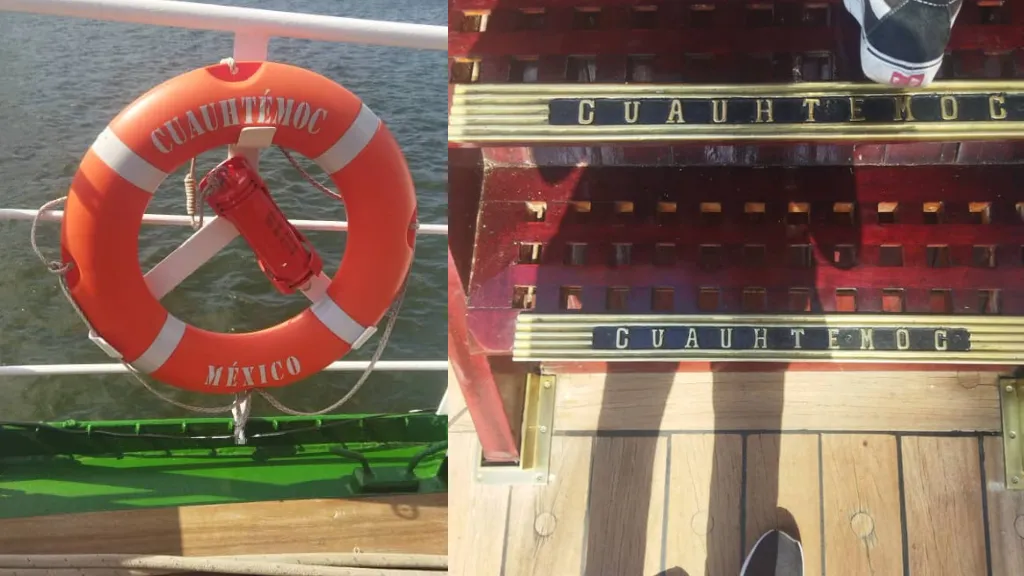
Si no eres mexicano o no conoces a profundidad la cultura azteca (como yo), seguro te preguntas el significado de esta palabra: Cuauthémoc: proviene de la lengua náhualt y significa el águila que desciende. Se adoptó en homenaje al último gobernante azteca (o tlatoani) que lideró la resistencia contra la invasión española en el siglo XVI. En la historia mexicana, constituye un signo de la resistencia de los pueblos indígenas frente a la conquista y opresión colonial.
A dia de hoy, el Cuauthémoc se considera uno de los barcos más bellos construidos por este astillero, y es que para su construcción se usó la mezcla de las técnicas modernas, con las técnicas usadas por los antiguos astilleros españoles; logrando sin lugar a duda, una belleza de la ingeniería naval. De lejos, parece un navío sacado de las películas de Piratas del Caribe o si te gusta el anime de One Piece , pero de cerca se puede observar los modernos radares y otros instrumentos, además es posible detallar las técnicas modernas con las que fue construido, aun así no le resta nada de magia, es hermoso.

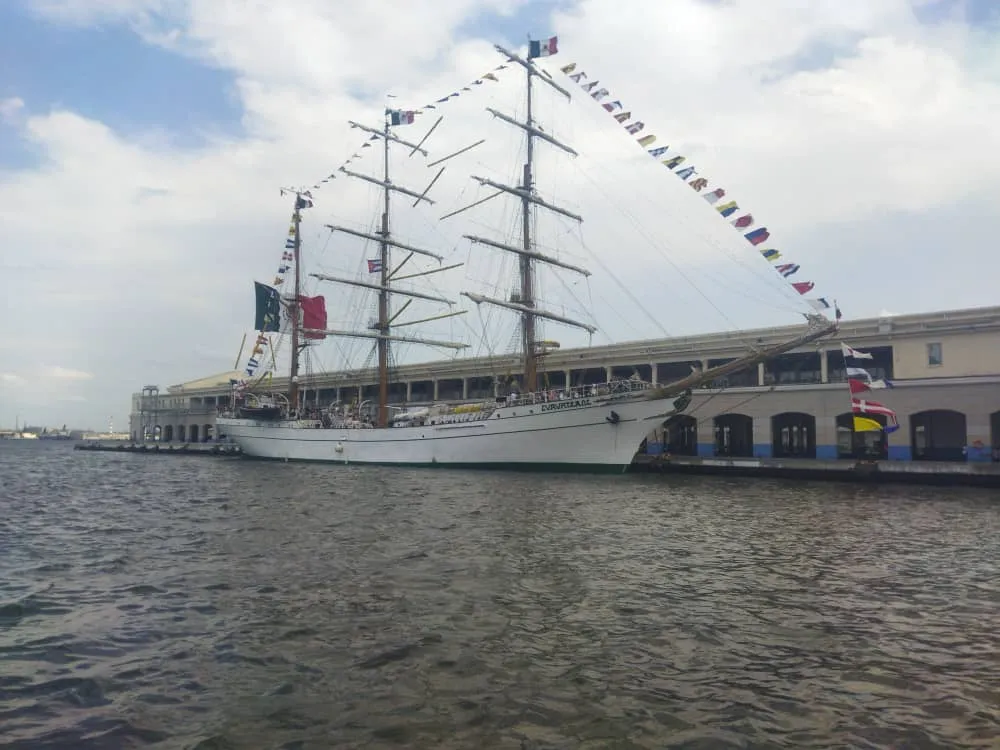
Si te fijas en las imágenes, seguro que te llama la atención la pintura de su casco. Estamos acostumbrados, a que los barcos estén pintados de colores oscuros y los de las Marinas de tonalidades grises. Entonces ¿Por qué blanco, verde y dorado? Según un tripulante, tiene dos motivos: el primero: es que el blanco, no absorbe los rayos del sol permitiendo que se mantenga una temperatura agradable durante los largos viajes que realizan y el color verde, en la línea de flotación, es una pintura que no deja que la vida marina se adhiera al casco, evitando los problemas de mantenimiento que esto trae y el segundo: una decoración que lo hace único: Estos colores rinden homenaje a la cultura, la identidad, la grandeza mexicana y lleva el mensaje de paz del pueblos mexicano hacia el mundo.

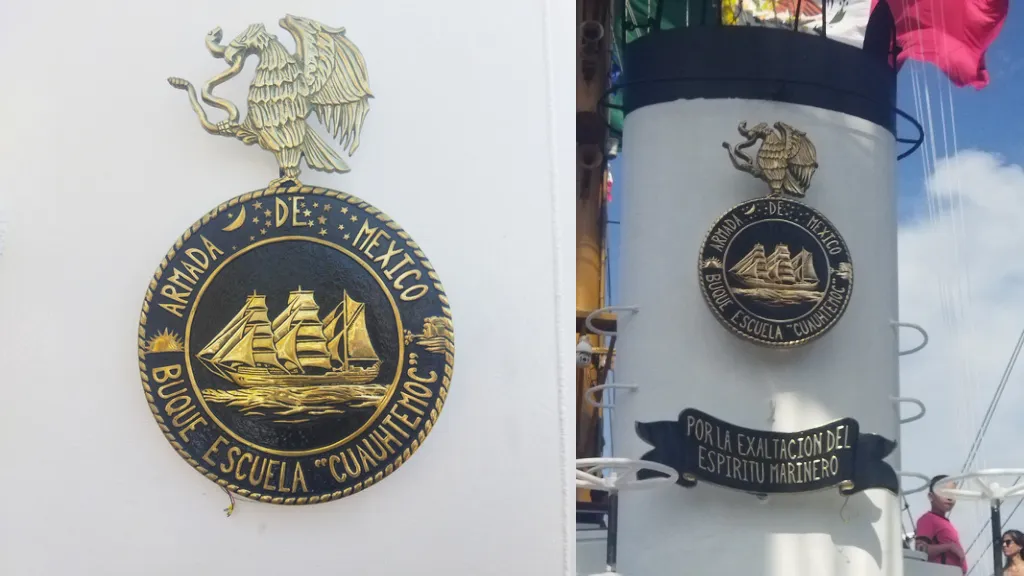
En el centro de la cubierta se puede ver el escudo de armas del Cuauhtémoc, que resume toda la historia que guarda el buque.
Arias , uno de los cadetes que nos guío durante la visita nos explica su significado a detalles:
Su origen español y el primer viaje hacia México para incorporarse a sus tareas, quedó reflejado en una rosa de los vientos, con la silueta del velero en el centro, con disposición a poniente (dirección España – México)
En el tope se encuentra Ehécatl, considerado el Dios de los Vientos (también se encuentra en el escudo de la Secretaria de Marina de la Armada de México)
En cuanto al nombre del buque, anteriormente te conté la historia que tiene detrás.

Durante el tour nos dijeron que el buque tenía una capacidad aproximada de hasta 90 cadetes y 180 tripulante. Consta con instalaciones como: aulas, talleres, modernos equipos de navegación para la formación de sus estudiantes y en algunas ocasiones ha servido como plataforma para investigaciones científicas en el mar.
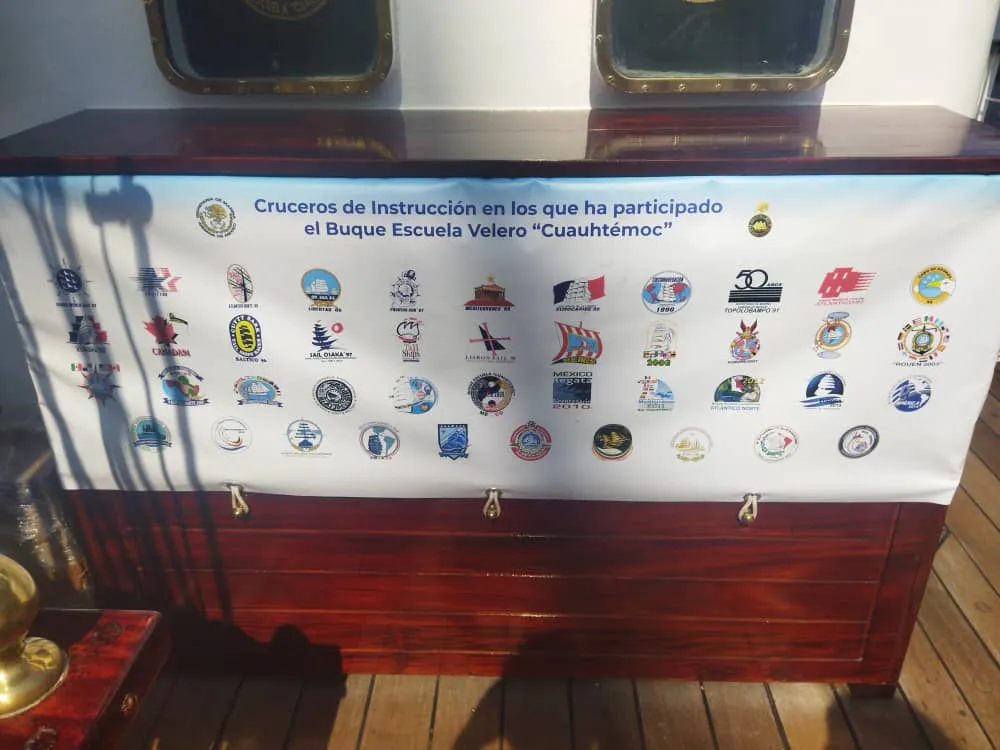
A lo largo de su servicio, el buque a cumplido diferentes misiones y de ahí surgió este su curioso apodo: durante su larga historia el barco ha visitado más de 212 puertos en 64 países, recorriendo una distancia de más de 700 mil millas náuticas y casi 6 mil días en alta mar ¡Esto equivale a 35 vueltas al mundo, una barbaridad! Además ha recibido hasta 8 condecoraciones de diferentes Marinas y Estados (las cuales se reflejan en un lateral de la cubierta con 8⭐) Convirtiéndose así en el más grande embajador de México.

En lo personal la visita al buque me fascinó, toda la tripulación muy amable con los visitantes, todos a bordo muy prestos a tirarse fotos y a compartir un poco de conocimiento con todo aquel que se interese, me gustó mucho eso. El barco te atrapa desde el primer momento, que junto al ambiente de la marina te hace difícil no imaginarte los tiempos de los piratas y corsarios en el Caribe, ojalá te haya contagiado un pco de esa vibra 😅
Si llegaste hasta aquí, gracias por leerme…
Así terminamos este artículo! Si hay algo que quieras añadir , te espero en los comentarios.
Espero que hayas disfrutado leyendo sobre el impresionante buque Cuauhtémoc y su historia. Si quieres seguir aprendiendo sobre temas fascinantes como este, asegúrate de suscribirte a mi blog y compartirlo con tus amigos.
No olvides compartir en Twitter para ganar $POSH y sígueme para estar al tanto de las últimas publicaciones. ¡Hasta la próxima!
ENGLISH
On April 19th, at around 10 a.m., as the sun began to heat up and businesses opened their doors, the rush of people trying to catch transportation to their destinations was abruptly interrupted by several loud bangs. Many of us, myself included, were left wondering, "What could be happening?" It wasn't a holiday or an important date, but the sound of gunfire was unmistakable. One burst was followed by a second, leaving no doubt that something important was going on.
Those loud bangs were actually a welcoming salute to a very special ship, but we'll get to that story soon.
If you're coming from Twitter, you'll already be familiar with the tradition I'm referring to (if not, feel free to check back on Twitter after reading this article).
In my introduction (which I'll share at the end in case you're interested in learning more about me), I mentioned that I'd be writing about engines and aviation. I never expected my first article to be about sails and navigation... but hey, let's get to know this Mexican traveler a little better.


In 1981, the Mexican president gave the order to build a new training ship to replace the old Cuauhtémoc, which had faithfully served in the Navy for 45 years before being decommissioned in 1979.
The former Cuauhtémoc was a three-masted barquentine sailboat, and the new one to be constructed had to be entirely unique, rather than simply a replica.
The task of constructing the new flagship for the Mexican Navy was entrusted to the renowned Celaya shipyards and workshops in Bilbao, Spain (as noted on the ship's deck). After considering various designs, it was decided to build a modern replica of 18th-century Spanish brigantines, inspired by their Spanish counterpart, the training ship Juan Sebastián de Elcano (which had also visited Cuba years before)
In 1982, the new training ship embarked on its maiden training voyage and has been serving in the Mexican Navy ever since. Its primary role is to train and educate cadets at the Naval Military School. However, it's much more than just a school... Keep reading to find out all about it!


If you're not Mexican or familiar with Aztec culture (like me), you're probably wondering about the meaning of this word: Cuauhtémoc. It comes from the Nahuatl language and means "descending eagle". It was adopted as a tribute to the last Aztec ruler (or tlatoani) who led the resistance against the Spanish invasion in the 16th century. In Mexican history, it represents a symbol of indigenous peoples' resistance against colonial conquest and oppression.
Today, the Cuauhtémoc is widely regarded as one of the most beautiful ships ever constructed by the Spanish shipyard. Its construction involved a mixture of modern and ancient techniques used by Spanish shipyards, resulting in an undoubtedly stunning feat of naval engineering. From a distance, it resembles a vessel straight out of Pirates of the Caribbean or One Piece, but up close, modern radar and other instruments are visible, as well as the modern techniques used to build it. Nevertheless, this doesn't detract from its magical beauty - it's truly a sight to behold.


If you take a closer look at the images, you'll surely be captivated by the striking paint job on the hull of the Cuauhtémoc. We're used to seeing ships painted in dark colors, and naval vessels in shades of gray. So why white, green, and gold? According to a crew member, there are two reasons: first, the white color doesn't absorb sunlight, helping to maintain a comfortable temperature during long voyages. The green paint used for the waterline prevents marine life from attaching to the hull, avoiding maintenance problems. Second, the unique decoration pays tribute to Mexican culture, identity, and greatness, carrying a message of peace from the Mexican people to other nations.


In the center of the deck, you can see the coat of arms of the Cuauhtémoc, which encapsulates the entire history of the ship:
During our visit, one of the cadets named Arias explained the meaning of the coat of arms in great detail:
The ship's Spanish origin and its first voyage to Mexico to begin its duties are represented by a compass rose, with the silhouette of the sailboat in the center facing westward (in the direction from Spain to Mexico)
At the top of the coat of arms, you'll find Ehécatl, who is considered the God of Wind (also featured on the emblem of the Mexican Navy's Secretariat of the Navy)
Regarding the name of the ship, I previously told you the story behind it.
During the tour, we learned that the ship has an approximate capacity of 90 cadets and 180 crew members. It boasts various facilities, including classrooms, workshops, and state-of-the-art navigation equipment for the training of its students. Additionally, the ship has served as a platform for scientific research at sea on some occasions.

Throughout its service, the ship has fulfilled various missions, and that's where its curious nickname came from. Over its long history, the vessel has visited more than 212 ports in 64 countries, covering a distance of over 700,000 nautical miles and spending almost 6,000 days at sea. This is equivalent to 35 trips around the world, which is quite remarkable! Additionally, it has received up to 8 awards from different navies and states, making it a true ambassador of Mexico around the world.

And that concludes this article! I hope you enjoyed reading about the impressive Cuauhtémoc vessel and its history.
If you want to keep exploring fascinating topics like this, make sure to subscribe to my blog and share it with your friends.
Don't forget to share on Twitter to earn $POSH and follow me to stay up to date on the latest posts. Thank you for reading, and see you in the next one!
*Sorry if I made a mistake, English is not my native language.
*The banners were created with Canva by me
*The photo were taken by me

